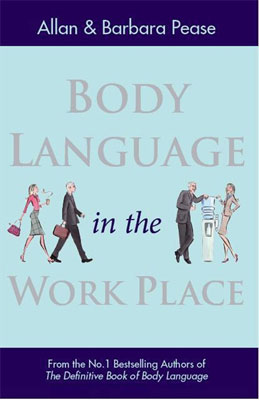Body Language In The Workplace

Body Language In The Workplace
Everything you need to know about body language in the work place - from the authors of multimillions-copy seller The Definitive Book of Body Language.
Clinch that deal or interview
Give the perfect presentation
Decipher and use international body language
Understand eye contact
Clarify confusing gender signals
From negotiating the office party to the best way to arrange your office furniture, Body Language In The Workplace will help you to identify and correct the body language that's letting you down.
Allan Pease's acclaimed Body Language has sold over 5 million copies. He has written five other No 1 bestselling books and has appeared on radio and television around the world.
Barbara Peaseis CEO of Pease International, which produces videos, training courses and seminars for businesses and governments worldwide. She is co-author of the bestselling book Why Men Don't Listen and Women Can't Read Maps, which has sold 11m copies worldwide. Their books were the subject of their first #1 movie hit, "Why Men Don't Listen and Women Can't Park Cars".
Body Language In The Workplace
Harper Collins Australia
Author: Allan and Barbara Pease
ISBN: 9781920816315
Price: $19.99
Interview with Allan Pease
Question: What does Body Language in the Workplace teach employees?
Allan Pease: Body Language in the Workplace teaches a number of things, one of the heavy things it concentrates on is first impressions because people form up to 90% of their impressions about you in under four minutes, which means if you screw the first four minutes up your not likely to get the job or make the sale or get someone to say yes to whatever you are trying to convince them to do.
Question: How does Body Language in the Workplace give people the ability to present the perfect presentation?
Allan Pease: There is a whole chapter just on presenting the perfect presentation. If you are going to a job interview, making a presentation, going for a pay rise or trying to be persuasive - you need to look right and know what to do, to know you'll receive a positive result. The Body Language in the Workplace book gives you the tips to give yourself the best chance of getting the nod to whatever you want.
Question: Is the Body Language in the Workplace good for management?
Allan Pease: It's not only based on how you turn up yourself and make an impression, it's how you make an impression as a leader and how you convince and persuade your team and get them to want to follow your leadership.
Question: Can you talk a little bit about the importance in arranging office furniture correctly?
Allan Pease: The shape of the table you sit at has a fairly dramatic affect on the outcome of how well it goes or friendly or not friendly the meeting is going to be. People understand these things on an instinctive basis but they can't quite articulate. For example we did the original studies on the possibility of an outcome on the shape of a table back in the 70's and what we found is that rectangular tables get the worst results when all other factors are equal, (that is the people negotiating a deal have not changed, the information in the proposition is the same deal). The table has a strong influence on how strong things are and the outcome. A rectangular table has the worst outcome and that's because they have been used for thousands of years to set up power positions. The person who sits at the head of the table facing towards the door is the most powerful position because they are monitoring who goes in and out. The least valuable position is the other end where the persons back is to the door. What this means is if you have a competitor you want to sit them at the end of the table, with their back to the door, when they sit there they don't feel right because there are people behind them and we have sensitivity to protecting our back. If you have your back to an open door, in a strange place you don't feel right and that's where you put people you want to rattle.
A square table will give you a better result because it has equal sides, but people do still tend to take sides. Whereas on a round table there are no sides and an equal spread; people are friendlier and speak in longer sentences on a round table than on a square or rectangular one.
Question: What inspired you to write this body language book?
Allan Pease: I wrote the original Body Language book in the 70's and the Definitive Book Of Body Language came out two years ago and contained information about dealing with anyone, anywhere and it was nearly a 500 page book; although the Definitive Book Of Body Language is my favourite book, it is a big book. There are specific applications of body language that people really want to know - they want to know about job interviews, applying for pay rises and convincing someone and those things kept coming up on our questionnaires. There will also be another book out in 2012 about the Body Language of Love because if you go to a pub or on a date how can you tell if someone really likes you?
Interview by Brooke Hunter
MORE



